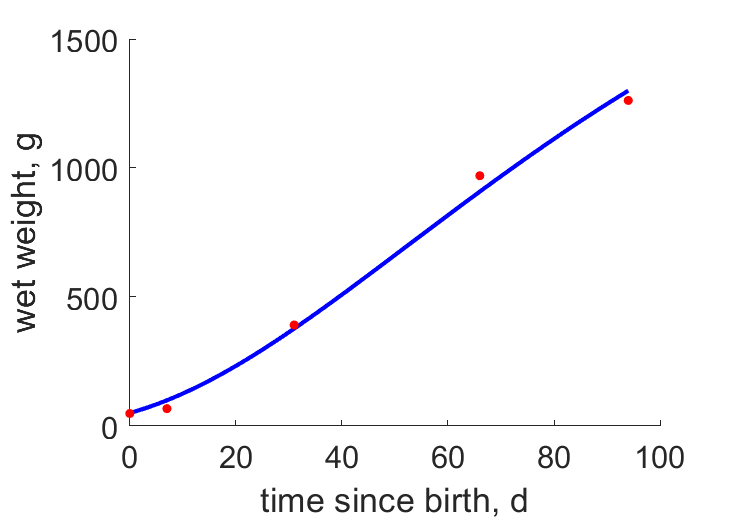Predictions & Data for this entry
| Model: std | climate: BWk | migrate: | phylum: |
| COMPLETE = 2.5 | ecozone: THp | food: bxCi, biHs | class: |
| MRE = 0.018 | habitat: 0iTf | gender: Dg | order: |
| SMSE = 0.001 | embryo: Tnsf | reprod: O | family: |
Zero-variate data
| Data | Observed | Predicted | (RE) | Unit | Description | Reference |
|---|---|---|---|---|---|---|
| ab | 30 | 29.46 | (0.01784) | d | age at birth | Chri2020 |
| tx | 3 | 3.055 | (0.01835) | d | time since birth at fledging | guess |
| tp | 100 | 101 | (0.009634) | d | time since birth at puberty | guess |
| tR | 365 | 365 | ( 0) | d | time since birth at first reproduction | guess |
| am | 1898 | 1884 | (0.007299) | d | life span | guess |
| Ww0 | 77.3 | 61.83 | (0.2001) | g | intitial wet weight | avibase |
| Wwb | 47.9 | 49.73 | (0.0382) | g | wet weight at birth | Chri2020 |
| Wwi | 2326 | 2353 | (0.01152) | g | ultimate wet weight | avibase |
| Wwim | 2529 | 2529 | (9.628e-05) | g | ultimate wet weight for males | avibase |
| Ri | 0.03288 | 0.03273 | (0.004581) | #/d | maximum reprod rate | Chri2020 |
Uni- and bivariate data
| Data | Figure | Independent variable | Dependent variable | (RE) | Reference |
|---|---|---|---|---|---|
| tW |  | time since birth | wet weight | (0.05392) | Chri2020 |
Pseudo-data at Tref = 20°C
| Data | Generalised animal | Tetraogallus himalayensis | Unit | Description |
|---|---|---|---|---|
| v | 0.02 | 0.02737 | cm/d | energy conductance |
| p_M | 18 | 967.6 | J/d.cm^3 | vol-spec som maint |
| k_J | 0.002 | 0.03956 | 1/d | maturity maint rate coefficient |
| k | 0.3 | 0.2999 | - | maintenance ratio |
| kap | 0.8 | 0.9523 | - | allocation fraction to soma |
| kap_G | 0.8 | 0.7986 | - | growth efficiency |
| kap_R | 0.95 | 0.95 | - | reproduction efficiency |
Discussion
- Males are assumed to differ from females by {p_Am} only
- mod_1: Pseudo-data point k is used, rather than k_J; Data set tp and parameter t_R are added, the latter replacing clutch interval t_N. Postnatal T is based on PrinPres1991, see get_T_Aves. See further the revision page, theme puberty
Bibliography